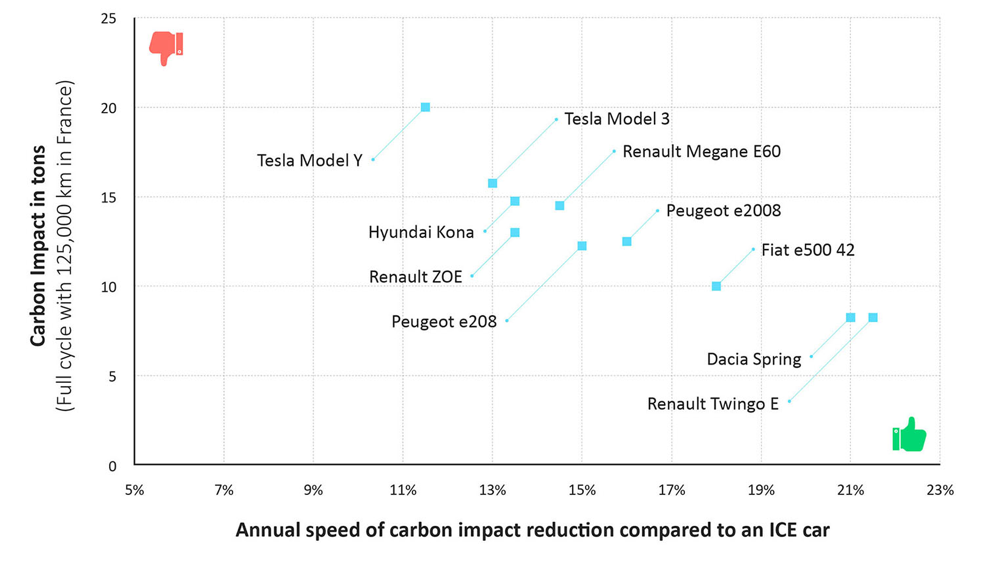By Frank Bunte CEO A2MAC1 and Christophe de Charentenay CEO M@Air
It's not easy to find your way around when you want to switch to an electric car to reduce your carbon footprint. There is much debate about the negative CO2 effect of battery manufacture, the carbon content of electricity depending on the country where you are travelling, the transport of the car from its production plant to its place of sale, etc. To try and guide customers, we have estimated the carbon footprint of the 10 best-selling electric car models in France and Germany. Indeed, even if, from 1 January 2024, manufacturers will have to communicate on the carbon footprint of batteries, no independent comparison applying the same method between models was available until now.
With the help of data from A2MAC1, a specialist in the technological and economic analysis of cars from all the major global manufacturers for more than 25 years, and by identifying the production sites of the models and battery cells, we were able to reconstruct an estimate of the carbon footprint of each of the best-selling electric cars in 2022 in France and Germany, i.e. a total of 15 models. This estimate does not use the manufacturers' own data and therefore does not commit them.
What are the results?
Unsurprisingly, the top group of the lowest carbon emitters according to our estimate is made up of small models: Twingo electric and Dacia Spring. If these models are driven in France for 125,000 km, they emit less than 9 tonnes of C02eq over their life cycle. When it comes to carbon, "Small is beautiful".
At the other end of the scale, the VW ID4, Tesla Model Y and Audi Q8 emit more than 18 tonnes on the same index, i.e. twice as much.
The hierarchy between models is almost the same if the vehicles are driven in Germany, but the carbon impacts are much higher there: around 15 tonnes for Twingo electric and Dacia Spring, while the large US and German models double the score: 30 tonnes.
Estimated carbon impact of the 10 best-selling EV models in France in 2022

Reading: the Peugeot e208 emits between 12 and 13 tonnes of CO2eq for 125,000 km of use (including manufacture and end of life) and reduces its CO2eq emissions by 15% per year over 10 years compared with a Peugeot 208 combustion engine. Detailed results and calculation method here and on www.a2mac1.com.
But if I choose to replace my combustion car at the end of its life with an electric car, how much will I reduce my CO2 emissions?
To answer this question, we have estimated the carbon impact of an equivalent internal combustion car using the same method: For example, we compare a combustion Peugeot 208 with an electric Peugeot e208.
Good news for users in France : If the motorist drives in France(1) and remains in the same category of vehicle, all transfers from internal combustion to electric vehicles not only show a reduction but, even better, the motorist succeeds in accelerating the reduction in emissions well beyond the -5% of emissions per year for the next 10 years.
The famous -5% per year that would allow us to keep the increase in global temperature below 2°C according to the IPCC forecasts. In the race for speed imposed on us by climate change, electric cars have their place, provided of course that they do not increase their annual distances and remain in the same category of vehicle.
Drivers in Germany will have a more constrained choice if they want to tick the -5% per year box and thus validate their climate contract in the field of mobility. For example, a BMW 3 Series diesel customer will not be able to reach this target by switching to a Tesla Model 3, but will have to choose an electric Opel Corsa or a Zoe. But if he is a more intensive driver: 17500 kms per year instead of 12500 Kms, his switch to electric in the same range (Tesla Model 3) will allow him to reduce his carbon impact by more than 5%.
The calculations confirm the common sense: Heavy models with high maximum speed are high carbon emitters even with electric propulsion pushed to its extremes with batteries with masses of over 700 kg!
While customers have a role to play in the low-carbon transition through their choice of vehicle, car manufacturers also have many opportunities to win the climate competition through design and manufacture. For example, for long distances, favouring fast charging rather than increasing battery capacity: an optimum is to be sought for comfortable motorway journeys with reasonably sized batteries. But also optimise energy losses linked to charging: measurements show significant differences between models, with up to 10% of Kwh 'evaporating' between the socket and the battery. Or to play cleverly with the electricity network by installing intelligent recharging systems that transform the batteries into mini-dams called to pass the network's consumption peaks. Finally, reducing the mass of vehicles is often a winning bet for reducing the carbon footprint.
So many innovations that will see the light of day if the climate labels come to indicate the vehicles that emit the least CO2 and if customers commit themselves to this race for the climate: It is won by travelling light and... slower.
(1) Assumption of 12,500 kms per year for 10 years. The more the annual distance travelled increases, the more the interest of switching to electric rather than staying with a combustion engine increases from a carbon point of view.